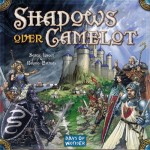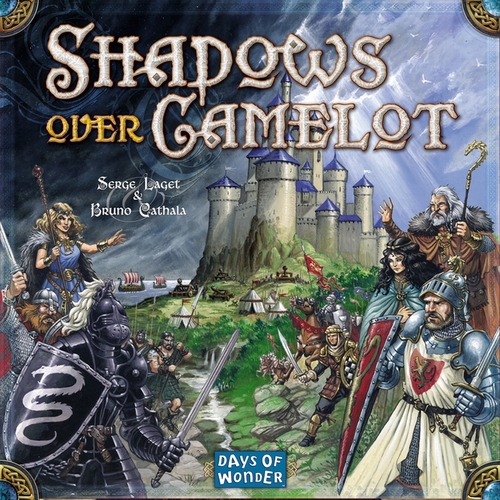
Shadows Over Camelot
Shadows Over Camelot is a co-operative gameplay experience that sets the players as Knights of the Round Table in King Arthur’s Camelot, fighting off invading armies and going on quests for the glory of the realm. Will the knights emerge victorious, or will the forces of darkness overtake the land?
Gameplay
The basic gameplay in Shadows Over Camelot is surprisingly simple: on their turn each player must choose one of three negative effects that will in some way hasten the defeat of good. They may choose to play one of the evil black cards, which will have a negative effect one one, or sometimes more, of the available quests, or add a siege engine to the fields outside of Camelot, or they may simply take a wound, putting themselves closer to death.
With that out of the way they may then choose to perform one heroic action, and the actions available to them will vary depending on where they are. At Camelot they can choose to draw more of the good white cards, or they can do battle against one of the siege engines. At the other locations spread across the board they have the option to play their cards to further their progress on those quests. They could also choose to move, either to or between quests and battles, or back to Camelot, or spend a turn healing or playing special cards.
Play progresses from player to player, each one advancing the forces of darkness and light, and eventually completing quests, either in favor of good or of evil. Each good victory earns one or more white swords at the round table, each defeat earns black swords. When twelve swords have been collected the game is over, and if there are more victories than defeats then the players have won. Of course, the game may not last that long. If all of the knights die out before that happens, or if there are ever too many siege engines surrounding camelot, or if there have been seven defeats, then the game is over and the players have lost.
Oddly enough the actual mechanics in play to complete the quests themselves generally fall down to simple set collection with the white cards. The majority of those cards are “fight” cards, which have a number value of 1 to 5 on them. For many of the quests the goal is to get certain “fight” cards, or certain combinations of them. For the Pict and Saxon war quests the players must play the cards in number order. For the black knight they attempt to get two sets of two to complete the quest, and the total of the cards used must value higher than any black knight cards played from the black deck to that point. For the Lancelot quest the players are attempting to complete a full house, and the Dragon quest requires three sets of three.
The remaining two quests: the Holy Grail and Excalibur, both lean on a slightly different tug of war style mechanic, with the players needing to advance the quest to a certain point before various cards played from the black deck can push them back too far from the goal.
Outside of trying to complete quests in the players favor the next major aspect of the gameplay is the management of the siege engines. There are several ways for more engines to appear on the board, with more introduced as the game advances and the one time quests are completed, and the game ends in a premature loss if they are allowed to build up too far. Players in Camelot can attempt to fight them off by playing fight cards and then rolling an eight sided die, if the total value on the cards played is higher than the number rolled the engine is destroyed, otherwise the player is wounded and has accomplished nothing, so it becomes important to properly manage the number of cards each player has available, and weigh the risk of using too many, or too few.
The last major aspect of the gameplay is the possibility that the knights may have a traitor in their midst. At the beginning of the game each player is given a loyalty card that will outline their role in the game. A traitor will win if the other knights lose the game, and so will be secretly working against the knights. There are a few ways to do this, primarily by playing the black cards face down on various quests, in the hopes that the other players will not know what number targets they need to beat. Since doing so can also allow a player to gain an extra white card the players will not be able to say for certain that a player playing face down is a traitor, but it may raise suspicion. Too much suspicious behavior can get the traitor accused and outed, changing their gameplay strategy and making it harder for them to win.
Components
The game itself is actually rather impressive, consisting of three decks of cards with very nice artwork, several large game boards, and a number of plastic miniatures for the knights, the various quest rewards, the siege engines, and the invading armies.
The main board consists of the primary locations and repeating quests. Castle Camelot, with the fabled Round Table taking up the majority of the space and serving as a sort of game clock, with the twelve spaces for the cardboard sword tokens to lay on, covers a full quarter of the board, and the fields for the siege engines takes up the middle. Two sides are given over to the Pict and Saxon wars, with card spaces laid out for each of the cards required to complete the quests. The other corner of the board is the tournament against the Black Knight. The other quests each appear on their own additional boards. This allows them to be turned over to their opposite side as the quest is completed and removed from the game. In the case of the Lancelot quest board, when the quest is completed the board is flipped opening up the quest against the Dragon.
The nice thing about all of the boards and quests is that they make it very easy to tell what it is you are supposed to be doing. Each of the quest sections contains explicit locations for each of the cards required to complete the quest, and has a box to show the rewards for completing the quest successfully, as well as the penalties for failing it. If you combine that with the helpful checklists listed on the character cards for each of the knights which are handed out to the players at the beginning of the game it’s entirely possible that players would be able to muddle through the game without even opening up the rulebook, although it would probably take a good deal longer.
That said the game comes with not one, but two rule books. One covering the game itself, as a whole, and the second going into more detail about each of the quests. Both are well designed and fairly easy to follow.
The artwork across all of the components is well done and consistent, and does a good job of establishing the Arthurian feel of the game.
Theme
While the artwork for the game really helps to bring the theme across, and the basic high-level gameplay helps to reinforce it, the turn to turn gameplay doesn’t really hold it up at all, unfortunately. There’s a bit of a disconnect involved when you are attempting to face down the rogue knight Lancelot by getting a full house before he draws five cards, or by driving back the invading Pict armies with a completed straight. Of course in any game you have to abstract out the thematic game goals into something obtainable with tabletop mechanics, but here there seems to be no connection between what you are actually doing and what you are supposedly doing.
The game makes up for this somewhat with the “special” cards in each deck. The Merlin cards can be used to undo the last black card played at a quest, or to instantly remove a siege engine, for example. Morgan la Fey shows up on several of the black cards, always with dire consequences for the knights. However, since those cards are the exceptions, rather than the rule, the players spend more time on most of the quests thinking about how to complete their sets rather than how to retrieve Lancelot’s armor, or Excalibur, and it makes it harder to get into the game on a thematic level, rather than a purely game level.
Replay
Replay value for Shadows Over Camelot will depend quite a bit on how much the players enjoy the basic quest. The win and loss conditions for the game, as well as the starting setup for the game are consistent from game to game, as are the quests that are available for the game, so the only real variation within the game will be from the randomness of the card draw.
That said, there are actually quite a lot of cards available, so the ebb and flow of the game could swing greatly from session to session. The players will need to react to different threats around the boards at different times or with different intensity, and a winning strategy from one session could spell doom in the next. Throwing in the random element of the possible traitor, and the possibility of playing as a different knight, and therefore with a different special ability, means that there are still several different ways for this game to go down.
Your milage may vary, and after several play throughs it could start to feel like just more of the same, or it could pull out just the right card at just the wrong moment and really surprise you.
Final Thoughts
As a co-operative game Shadows Over Camelot can provide a nice and engaging gaming experience. The game itself looks very attractive, and while the gameplay doesn’t really make you feel like knights taking on the forces of darkness it does manage to bring the fun and ratchet up the tension, especially when the siege engines start to come out in force. It manages to strike a good balance for a co-operative game, being complicated enough to be interesting without being so complicated that it will turn off the more casual players. And if at least a few people are familiar with the rules of the game it really shouldn’t take more than an hour and a half to play, either, so it’s long enough to sink your teeth into, without reaching a point where it is dragging on. It does a good job at keeping the players engaged and is overall quite enjoyable.

Shadows Over Camelot by Bruno Cathala and Serge Laget
Published by Days of Wonder
